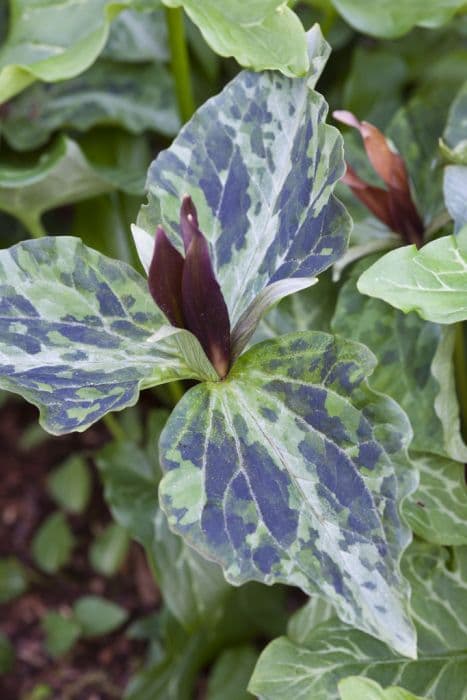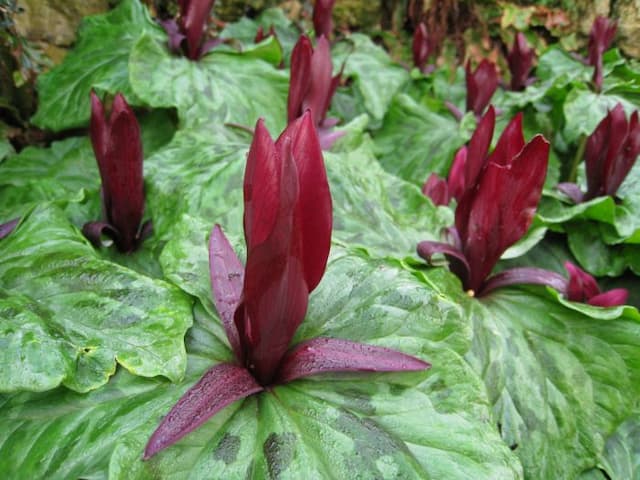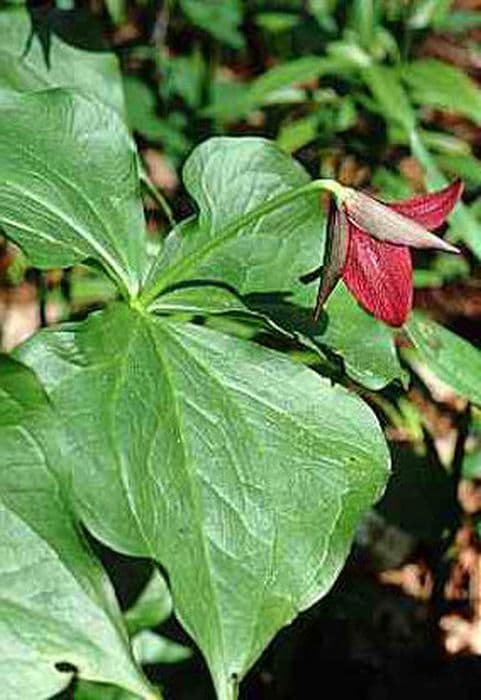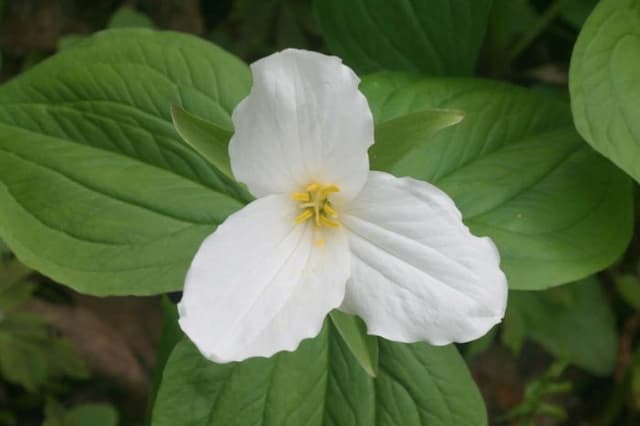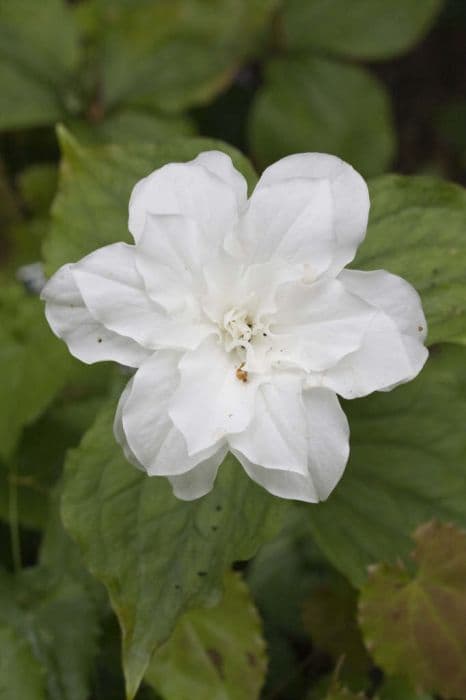Pacific trillium Trillium albidum

ABOUT
The plant known as the white wake robin features a solitary, large, three-petaled flower ranging in color from pure white to a pinkish tone. This flower is distinctly trillium, with three broad leaves arrayed in a whorl beneath the bloom, a signature look of its kind. At the base of the flower, one can observe the yellow stamens and a trio of sepals that are typically green and may sometimes recurve away from the blossom, providing a contrasting backdrop to the delicate petals. The white wake robin blooms in the spring, presenting a striking visual display, which is further complemented by a lush forest backdrop in its native habitat. The plant emerges from a short, stout stem that also gives rise to a singular, upright flower. It's a perennial favorite among gardeners and wildflower enthusiasts for the simple elegance it adds to the shady woodland settings where it often thrives.
About this plant
 Names
NamesSynonyms
Giant White Wakerobin, White Trillium, Pacific Trillium, Western White Trillium, Giant White Trillium
Common names
Trillium albidum.
 Toxicity
ToxicityTo humans
The plant in question, commonly known as the giant white wakerobin, is not widely known to be toxic to humans. However, eating any plant not known to be edible should be done with caution, and this plant's parts, like many wild plants, could potentially cause stomach upset or allergic reactions in some individuals if ingested.
To pets
The giant white wakerobin is not commonly listed as a toxic plant to pets like cats and dogs. Nevertheless, as with humans, ingestion of non-food plants can lead to gastrointestinal distress or allergic reactions in pets. If a pet ingests a part of this plant, monitoring for symptoms such as vomiting or diarrhea is advisable, and a veterinarian should be consulted if any concerning symptoms arise.
 Characteristics
CharacteristicsLife cycle
Perennials
Foliage type
Deciduous
Color of leaves
Green
Flower color
White
Height
1-2 feet (30-60 cm)
Spread
1-2 feet (30-60 cm)
Plant type
Herb
Hardiness zones
5
Native area
Northwestern United States
Benefits
 General Benefits
General Benefits- Supports Local Ecosystems: Trillium albidum, commonly known as the white trillium, provides essential habitat and food for native pollinators and other wildlife species.
- Enhances Biodiversity: The inclusion of Trillium albidum in natural landscapes helps increase plant diversity, which is critical for the health and resilience of ecosystems.
- Beautification: With its striking white flowers, Trillium albidum adds aesthetic value to forests, woodland gardens, and naturalized areas, enhancing the visual appeal of such environments.
- Educational Value: Trillium albidum serves as an educational tool for botanists, ecologists, and students interested in learning about native plant species, forest ecology, and conservation efforts.
- Cultural Significance: As a native North American (Western United States) species, the white trillium is often used in cultural and historical contexts, enriching the heritage of the regions where it naturally occurs.
- Ecosystem Indicator: The presence of Trillium albidum can serve as an indicator of a healthy forest ecosystem, as it thrives in undisturbed woodland environments.
- Conservation and Restoration: Trillium albidum is often used in conservation and reforestation projects to restore native vegetation and to rehabilitate disturbed land.
- Seasonal Interest: White trillium provides seasonal interest in gardens and woodlands, especially in spring when it blooms, signaling the arrival of warmer weather and the rejuvenation of the plant life cycle.
 Medical Properties
Medical PropertiesThis plant is not used for medical purposes.
 Air-purifying Qualities
Air-purifying QualitiesThis plant is not specifically known for air purifying qualities.
 Other Uses
Other Uses- Garden Ornamental: Trillium albidum, commonly known as Wake Robin, is often used for ornamental purposes in shade gardens due to its attractive three-petaled white flowers.
- Educational Resource: The plant serves as an educational tool to demonstrate the life cycle of a perennial and the structure of a trillium to botany students.
- Culinary Decoration: Although not commonly eaten, the petals of the Wake Robin can be used as elegant, natural garnishes for culinary dishes, adding a touch of wilderness aesthetic.
- Nature Photography: With its striking appearance, Trillium albidum is a popular subject for nature photographers, especially in woodland settings.
- Ecosystem Indicator: Since Trillium albidum thrives in moist, rich woods, its presence can indicate the health of a forest ecosystem.
- Companion Planting: Wake Robin can be planted alongside other woodland species such as ferns, creating a diverse understory in forested garden areas.
- Cultural Symbol: In some cultures, the Trillium is seen as a symbol of purity and is featured in various art and literature works.
- Botanical Art: Artists may use Wake Robin as a model for botanical illustration, capturing its unique form and symmetry.
- Wildcrafting: Enthusiasts of wildcrafting, or foraging for wild plants, may collect Wake Robin for personal herbariums or as part of nature-related crafts.
- Floral Arrangements: Though not a traditional cut flower, the Trillium albidum can be incorporated into wildflower arrangements for a distinctive woodland aesthetic.
Interesting Facts
 Feng Shui
Feng ShuiThe Trillium is not used in Feng Shui practice.
 Zodiac Sign Compitability
Zodiac Sign CompitabilityThe Trillium is not used in astrology practice.
 Plant Symbolism
Plant Symbolism- Purity: The white color of the Western Wake Robin's petals often symbolizes purity and innocence, reflecting a sense of cleanliness and virtue.
- Trinity: The three-petal structure can represent the concept of trinity in religious and spiritual contexts, such as the Christian Holy Trinity or the interconnectedness of mind, body, and spirit.
- Balance: The symmetry of the three leaves and petals can symbolize balance and harmony within oneself and in nature.
- Modesty: The way the plant's flowers sometimes tilt or hang downwards has been seen as a sign of modesty or humility.
- Healing: Some Native American tribes used Trillium as a medicinal plant, leading to its association with healing and the restoration of health.
- Resilience: As a woodland plant that returns and blooms each spring, it represents resilience and the ability to endure challenging conditions.
 Water
WaterThe Giant Wake Robin should be watered when the top inch of the soil feels dry to the touch. For outdoor plants, this typically means watering once per week with about one gallon of water, ensuring a thorough soaking. During the growing season in spring and early summer, watering frequency may increase due to higher temperatures and sunlight exposure. Water should be applied directly to the base of the plant to avoid wetting the foliage, which can lead to fungal diseases. Over the winter months, when the plant is dormant, reduce watering significantly to prevent root rot.
 Light
LightGiant Wake Robin thrives best in partial to full shade. It can be planted under a canopy of deciduous trees, which provide filtered sunlight and some protection from the intense midday sun. The ideal spot for this plant offers bright, indirect light or dappled shade, which mimics its natural woodland habitat.
 Temperature
TemperatureGiant Wake Robin prefers cool to moderate temperatures, with an ideal range between 60 to 70 degrees Fahrenheit. It can tolerate a minimum temperature of about 50 degrees Fahrenheit and a maximum of around 80 degrees Fahrenheit. Extreme temperatures, both hot and cold, should be avoided to keep the plant healthy and thriving.
 Pruning
PruningPruning of the Giant Wake Robin is generally not necessary. Its growth habit and natural shape do not require regular cutting back. However, any damaged or dead leaves can be removed to maintain plant health and aesthetics. Pruning, if needed, should be done after the flowering season in late spring or early summer.
 Cleaning
CleaningAs needed
 Soil
SoilThe best soil mix for Pacific Trillium is a well-draining, rich, and loamy soil with adequate organic matter. A suitable pH for this plant ranges from 5.5 to 7.0, favoring slightly acidic to neutral conditions.
 Repotting
RepottingPacific Trillium rarely needs repotting and can be left undisturbed for several years because it does not appreciate frequent root disturbance. Typically, repotting every 3-5 years is adequate, or when the rhizomes fill the pot.
 Humidity & Misting
Humidity & MistingPacific Trillium thrives in moderate to high humidity levels, mirroring its native understory habitat. While precise humidity levels aren't strictly defined, aiming for above 60% is beneficial for this plant.
 Suitable locations
Suitable locationsIndoor
Provide bright, indirect light and cool temperatures for Pacific Trillium.
Outdoor
Plant in dappled shade, keep soil moist but not soggy for Pacific Trillium.
Hardiness zone
5-9 USDA
 Life cycle
Life cycleTrillium albidum, also known as the Pacific trillium or the Giant white wakerobin, begins its life as a seed, often dispersed by ants through a process called myrmecochory. After germination, a rhizome develops from which a single leafy shoot emerges, marking the seedling stage; in this stage, the plant relies heavily on symbiotic relationships with mycorrhizal fungi for nutrients. As the plant matures, it enters its vegetative stage, developing a characteristic whorl of three leaves and, annually, a single upright stem. After a few years of growth, once mature enough, it produces distinctive white flowers during the flowering stage, which can then be pollinated by insects, especially bees and beetles. Following pollination, the flowers develop into berry-like fruits containing seeds, thus completing the reproductive stage. Finally, Trillium albidum enters a period of dormancy during the winter, with the aerial parts dying back to the ground and the plant surviving underground through its rhizome until the next growing season.
 Propogation
PropogationPropogation time
Spring
Propogation: Trillium albidum, commonly known as the white trillium, is a perennial plant that can be propagated through its seeds or division of rhizomes. The most popular method of propagation for this plant is by seed. The best time to collect seeds for planting is late summer to early autumn when the fruit has ripened. After collection, the seeds should be cleaned and then sown immediately in a cold frame or directly outdoors, as they require a period of cold stratification to break dormancy. This process involves storing the seeds at temperatures of 32 to 41 degrees Fahrenheit (0 to 5 degrees Celsius) for several months before spring planting. Once stratified, seeds can be planted in a shady area with well-draining soil, where they will germinate and grow into mature white trillium plants over several years.

